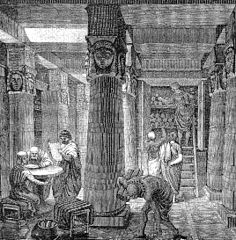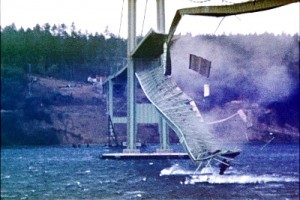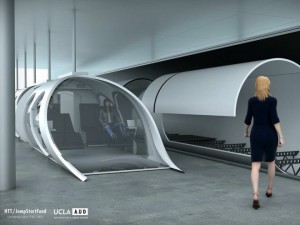The Egg Drop Competition, Reconsidered
The egg drop competition has been a staple of elementary and middle school science classes since long before I was born. You create a container that will allow an egg to survive a drop of several stories, while still being able to put the egg in the container on-site. It’s a good exercise in creative thinking for kids, not to mention the fun factor.

An egg
You’ve got a few basic strategies: the first—and simplest—is the “giant wad of padding” strategy, which usually works pretty well. The most common version of this is the big box filled with packing peanuts, but I’ve also seen bags made out of pillows and bubble wrap spheres. (Natch: I made all my kids and grandkids think more “outside the box” than this.)
The next most common is the parachute design—usually one of the more reliable ones, assuming your parachute works. Pretty self explanatory…and it’s the design I used myself as a kid. (A little extra padding didn’t hurt, of course.)
There are also a ton of weirder designs out there: flexible chopstick frameworks surrounding a bubble-wrap core, eggs padded in breakfast cereal or popcorn, containers filled with water (although that’s banned in many competitions), the panty hose box (suspend the egg in panty-hose in a box, and the stretchiness of the fabric will keep it from hitting the sides and breaking), and the small padded box covered in springs.
Then, of course, you have my cousin John’s approach. He always was too smart for his own good, so he decided to come up with something a bit more unusual. When he showed up for school that day, it was with a container shaped like a rocket; the thing even had landing struts. It was even weighted so that the container always fell bottom-first. What he didn’t tell anyone, of course, was that the rocket was weighted with an actual radio controlled model rocket engine and had a thin paper coating over it.
When the teacher dropped his off the roof (all us kids standing below), John, who’d been hiding his remote in his pants, pulls it out to activate it. Unfortunately, it didn’t go quite as anticipated and shot off sideways toward the kids. Guess who it hit?
And that’s the story about how I got a broken rib, minor burns, and a face covered in egg. It wouldn’t be the first or the last time that hanging out with my cousin got me injured, either. At least that time I didn’t get in trouble for it.
History’s Arc of Innovation
I always hear people going on and on about how we’re in the greatest age of innovation and technology, with more amazing things being invented now than ever before. I’ll have to beg to differ there, and I can back up my argument, too:

The Library at Alexandria
- The oldest folding chairs date back to the 14th century B.C. from Ancient Egypt.
- The first fishing reel dates all the way to at least 4th century China.
- Beer predates recorded history, and has even been linked to the rise of civilization.
- Wine predates recorded history and is possibly almost as old as beer.
- Reclining armchairs date back to the Napoleonic War.
- Organized sporting events predate recorded history.
- The oldest dice ever found are more than 5,000 years old—coincidentally, they were found in the oldest ever backgammon set.
- Humans bred dogs before recorded history, or even the invention of agriculture.
- The earliest form of chess originated in the 6th century in India.
- The Arawak Native Americans invented the barbeque grill long before any Europeans showed up in the Americas.
- Playing cards were invented in China during the 9th century.
- The written word is between six and nine thousand years old; the first proto-books popped up not too long after.
- The housecat was domesticated in Ancient Egypt, though some experts believe that the process started long before that.
- The oldest known direct ancestors of the guitar are well over 3,000 years old.
- Baseball caps are more than a century and a half old.
- People began drinking coffee—in Yemen—in the 1400s.
- Native Americans, probably the Arawak, invented the hammock in the Caribbean more than a thousand years ago.
So, the next time someone dismisses ancient peoples as primitive: just smile and nod, then kick back in a hammock with a beer and a good book.
Learning from The Tacoma Narrows
The Tacoma Narrows Bridge collapse is one of the best known architectural failures in modern history, and it is used as a lesson by everyone, from architects and civil engineers to insurance agents.
Built in 1940 across the Tacoma Narrows in Washington State, the suspension bridge lasted less than a year before collapsing. The only casualty was a dog stuck in a car.
Due to a very tight budget, the bridge was constructed with lightweight girders, as per the lowest bid design. (In my work, that Tacoma Narrows lesson is one of the many reasons I don’t just go for the lowest bid). During construction, the bridge’s thin design, low weight, and less-than-durable construction resulted in frequent vibrations and shaking whenever the wind picked up. It got so bad that the workers nicknamed it Galloping Gertie. Not exactly a trust-inspiring name.

The Bridge Collapses
The bridge began undergoing severe oscillations (or, to be a bit less technical about things: the bridge shook itself to bits) under heavy winds on November 7th, 1940.
I won’t go in depth on the science behind the collapse; you can find that easy enough. I’m more interested in what lessons it gives us about ignoring nature. For all the amazing things mankind has done, we still need to respect nature or it will come back to bite us. All of our technology and inventiveness allows us to stand up to nature, but push it around? Not a chance. We need to foster a design philosophy that promotes working with nature, not against it.
This sounds like hippy talk, I know, but it’s nothing new. Heck, the idea goes back millennia. Look at any number of cultures that lived in hot climates—high ceilings, big windows, light colored paint. Cultures that live with heavy rain? You build your foundations strong, angle your roof, and pick your building site really carefully.
Why’d I decide to blog about Tacoma Narrows, when so many people already use it as a lesson? Well, I think some people missed that one—like my son-in-law, who decided to have his shed built by the cheapest contractor: at the edge of a hill, with no real foundation to speak of. He’s going to be picking his tools out of the stream for weeks.
Inventing the Hyperloop
The way I figure it, most billionaires are just investors: they’re simply using money to make more money. It’s not real exciting, but if you really want to be rich that bad, I guess it works.
A few billionaires are more interesting to me, though—guys like Bill Gates and Elon Musk, who actually get involved in producing new things.
Elon Musk is especially noteworthy right now. He’s started a private space corporation (SpaceX), co-founded Tesla Motors, and most recently is pushing for the Hyperloop.

The Hyperloop
The Hyperloop is a conceptual transportation system that would be able to move passengers at speeds twice, or more, of a passenger aircraft. Essentially, it’s a high speed train in a sealed tunnel with most of the air pumped out, letting it speed unhindered by air resistance, track friction, weather, or any of the difficulties facing other modes of high-speed transportation.
This thing could potentially hit thousands of miles an hour (depending on how low they can keep the pressure in the tube; that’s the big limiting factor). Rather than using maglev (magnetic levitation) or wheels, the train would float on air rails, very similarly to how an air hockey table works, and it would be accelerated by linear induction motors.
This concept isn’t new. The idea of vacuum trains has been around for decades. This is one of the first attempts to really build one, though. While all of the initial design work was done by Musk’s engineers, he then took the unusual step of releasing all of the designs and plans. All of them. He turned it into an open source project.
Most of the current work on the project is by a group of engineers called Hyperloop Transportation Technologies. (The old saw about engineers getting to name companies holds true here).
That’s not to say that it doesn’t face plenty of troubles of its own. They’ve still got to figure out how to handle earthquakes, any number of technical issues, and even zoning issues. But I feel confident saying that we’ll get to see this fly one day.





